Samsung Galaxy S 4 Review - Part 1
by Brian Klug on April 24, 2013 12:01 AM ESTBattery Life and Charge Time
The Galaxy S 4 features a removable 9.88Wh battery with 3.8V chemistry. The battery design is par for the course for any high end smartphone, but the fact that it's removable remains a staple of the Galaxy S design. Whether or not the bulk of consumers actually use the flexiblity offered by a removable battery is up for debate, but there's no doubt about the fact that Samsung has a strong following of users who appreciate the feature.
Unfortunately, only having access to the Sprint version of the Galaxy S 4 to review, most of our battery life tests on the cellular network aren't all that useful. The good news is that our WiFi tests should at least give you an idea of how well the SGS4 will compare to the HTC One when both are on the same network. We're using the latest revision of our smartphone battery life test to compare performance of all the key players here. This is now our sixth revision of the battery life test, and we feel is the optimal balance between challenging workloads and idle time. The basic overview is the same as the previous test — we load webpages at a fixed interval until the handset dies, with display set at exactly 200 nits as always. Power saving features are disabled if they turn on automatically, and background account sync is disabled. The test is performed over both cellular data on all available air interfaces and over WiFi in an environment with good signal levels. The new test has decreased pause time between web page loads and added a number of JavaScript-heavy pages. I sat down with some UMTS RRC (Radio Resource Control) emulator tools and also made sure we had a good balance of all the RRC states (DCH, PCH if possible, FACH, IDLE) so we weren’t heavily biased towards one mode or the other.
As the most relevant comparison of platforms we have today, we'll start with the WiFi version of our web browsing test:
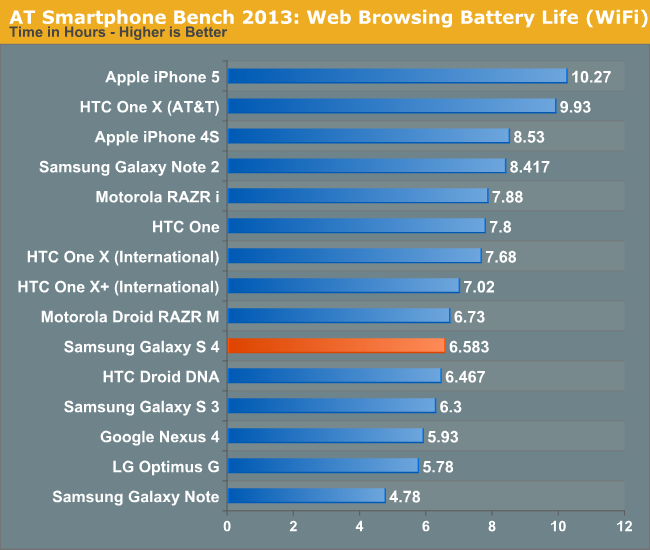
On WiFi the Galaxy S 4 falls behind the HTC One by an appreciable amount, however there's still an improvement in battery life compared to the Galaxy S 3. The Galaxy S 4's battery life isn't bad by any means, but do keep in mind that this is a large phone with a large display and a very powerful SoC. For much of the past year we've been talking about an increase in dynamic range in total platform power of high end smartphones and the Galaxy S 4 is no exception. Run it at full brightness or keep many cores running in their maximum performance states for a considerable period of time and you'll be greeted by a phone that's quickly in need of a power outlet.
As I mentioned earlier, we only have access to the Sprint version of the Galaxy S 4 at this point which unfortunately means that our 3G results aren't all that comparable to other devices here.

Even on Sprint, the Galaxy S 4 does surprisingly well.
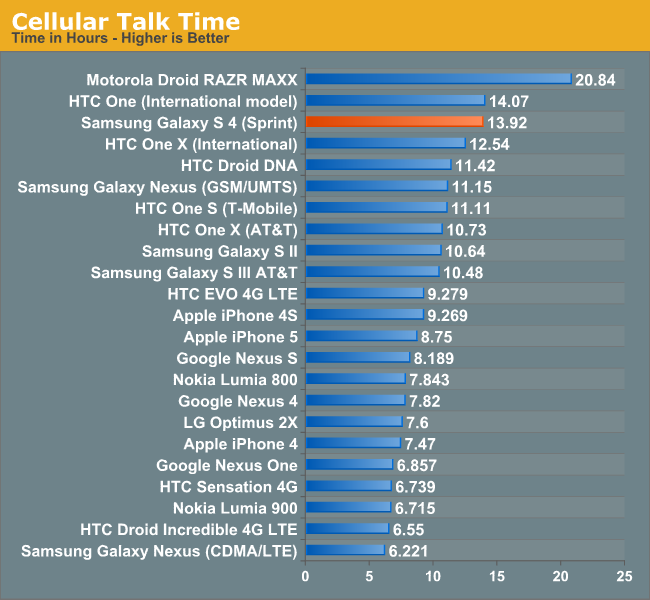
Talk time is excellent on the Galaxy S 4, with the phone delivering effectively the same battery life as the HTC One. Without having to power on that huge display, the Galaxy S 4 can last for a very long time on a single charge.
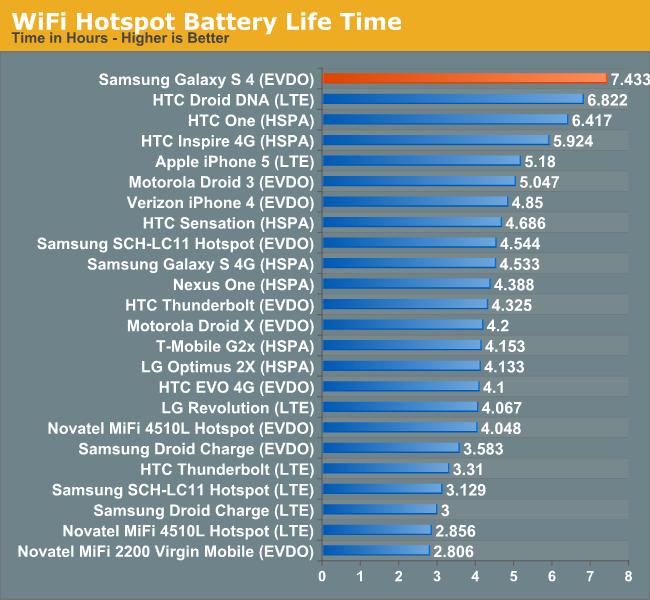
A combination of the Sprint network and the fact that the Galaxy S 4's display remains off during our hotspot test resulted in great battery life here as well. Again, this data isn't all that useful if you're not on Sprint but Samsung tells us we should be able to get our hands on an AT&T SGS4 in the not too distant future.
Charge Time
Samsung appears to implement Qualcomm's Quick Charge specification in the Galaxy S 4 and its bundled charger. I realize we haven't done a deep dive into what Quick Charge is and how it works, but I'll try to go through a quick explanation here. Most conventional chargers are linear, they take a fixed amount of input current (at 5V) and pass it along to the device being charged. The problem is that at deeply discharged states, the device's battery might be at a substantially lower voltage. A traditional linear charger won't change the current supplied based on the voltage of the battery being charged, and as a result can deliver sub-optimal charge times. When implemented, Qualcomm's Quick Charge technology can vary output current based on the voltage of the battery being charged, which results in less power being dissipated as heat and more being delivered to charging the battery itself. The table below helps illustrate the savings:
Quick Charge, at least in its currently available 1.0 specification, is still bound by the 5V limits of the USB BC 1.2 specification. The next revision of Quick Charge will enable higher voltage operation for even faster charge times.
| Qualcomm Quick Charge 1.0, Theoretical Example | ||||||
| Input Current @ Voltage | Input Power | Output Current @ Discharged Battery Voltage | Output Power | |||
| USB BC 1.2 - Linear Charger | 475mA @ 5V | 2.375W | 475mA @ 3V | 1.425W | ||
| Qualcomm Quick Charge 1.0 | 475mA @ 5V | 2.375W | 700mA @ 3V | 2.100W | ||
The non-linear nature of Quick Charge significantly shortens charge time, particularly in the very early stages of charging when the device's battery is presumably fully discharged. As the device's battery voltage increases, current delivery tapers off and the QC advantage is no longer as great as a standard USB BC 1.2 solution. The end result though is significantly improved charge times.
The graph below shows the benefits of using Samsung's own charger vs. a standard charger that implements the USB BC 1.2 specification. When used with the bundled charger, the Galaxy S 4 recharges much faster than HTC's One, despite using a larger battery. Obviously the Galaxy S 4 will charge with any USB charger, but the charge time will simply be longer. Samsung uses a voltage divider and signals the presence of their own charger by sending 1.2-1.3 V across the D+ / D- pins, this is similar to what Apple does with 2.0 or 2.8 V across the pins for various USB chargers they've shipped over the years. This signaling is essentially Samsung's proprietary tablet charging signaling which they've employed on the Galaxy Note 2 and now SGS4, in fact the two use the same exact charger, so it's worth tossing out your old ones and getting the appropriate one to take advantage of the faster charging.
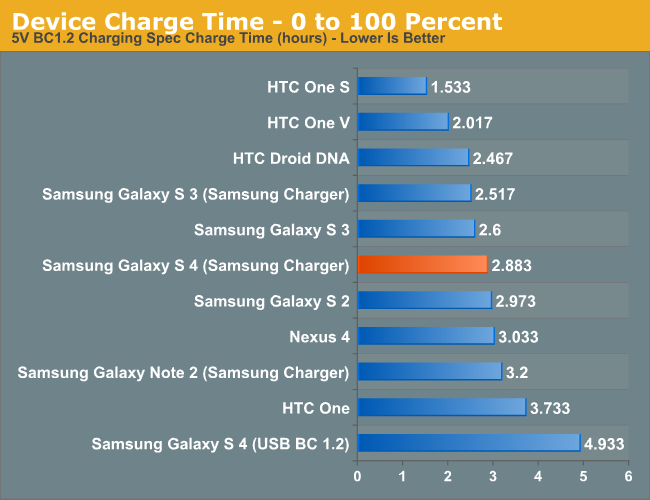


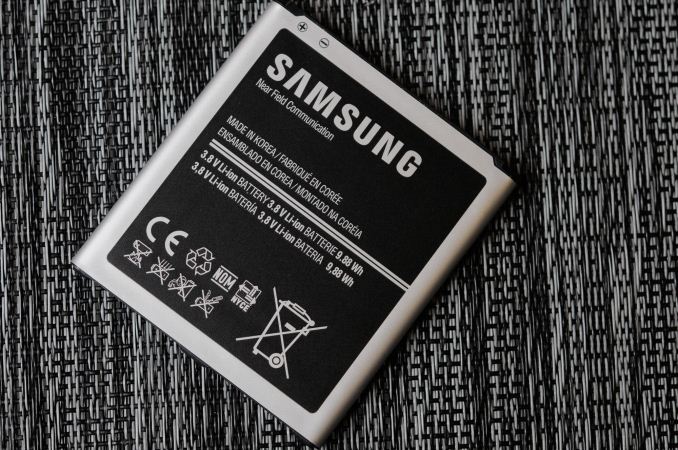








335 Comments
View All Comments
Solandri - Thursday, April 25, 2013 - link
Structural engineer here. The reasons Roffles12 cited are valid, objective engineering reasons to use plastic over metal. When you're designing an item and selecting what material it's made of, a myriad of factors come into play including: elastic modulus (flexibility), toughness (ability to withstand piercing), hysteresis (energy absorbed during bending vs. energy bounced back), yield strength (how much stress it can take before it breaks), fatigue (tendency for cracks to grow), fracture strength (tendency for cracks to propagate), corrosion resistance, heat and electrical conductivity, thermal expansion, weight, density, and yes cost.For a phone with an expected 2-3 year lifespan (plastic tends to get brittle after many years), plastic is actually superior to metal in many of these characteristics. A similar thing happened in the 1940s and 1950s with cars. As they got faster, more people were dying in accidents. Automakers responded by building the cars stronger and stronger, and more people died. Finally they took a step back and did some crash testing, and found that making the exterior stronger was actually the *worst* thing they could do to protect the people inside. It transmitted all the impact forces directly to the occupants. Now they build cars with crumple zones which bend and yield to absorb the energy of an impact, while a stiff passenger compartment protects the occupants. Similarly, if designed right, a phone with a flexible plastic exterior but a strong interior construction can survive impacts better than one with a stiff metal exterior.
Unfortunately, for most of the uneducated masses, their analysis is much simpler: metal = good, plastic = cheap. Which is really too bad since it will lead to them making a lot of non-optimal purchase decisions. About the only plastic which has escaped this stereotype is carbon fiber, which is just strengthening fibers embedded in a plastic substrate. Probably because the stuff is expensive, and most people automatically assume expensive = good.
UpSpin - Thursday, April 25, 2013 - link
I normally don't sit in my smartphone and throw it with 100 km/h against a wall. And I don't know a car made out of plastic, the cars I drive are made out of steel and aluminum and last more than 10 years.I don't understand what you want to tell us at all with your car story, because it's not related to smartphones at all.
You also forget that the front of the smartphone consists of glass! which breaks easily. So if your body is highly flexible and very soft, it won't break, but your glass will have to absorb the whole energy and break. And as you can see in the S4 photos, there is barely a bezel thus no 'crush zone'.
You also don't buy a rugged device which must withstand permanent drops. (I haven't dropped my 3 years old smartphone even once).
I agree with you that plastic has its advantages compared to metal but so does metal compared to plastic. Plastic is more flexible which is negligible because the glass isn't flexible. Plastic breaks easily, wheras metal deforms, whatever you prefer.
And as you said, plastic is a broad term. You can find cheap and expensive variants (Kevlar, carbon fiber), with different properties (soft, hard, ...) and different finishes (matt, glossy).
But the plastic (or let's say polycarbonate) Samsung uses is shiny, glossy, cheap.
nerd1 - Thursday, April 25, 2013 - link
Phones get dropped on hard surfaces a lot during its lifetime. Metal gets dent, while polycarbonate ( which is NOT cheap material) absorbs the shock and keeps its shape. If you are gonna baby your phone you may be fine with metal exterior but I do not.gnx - Friday, April 26, 2013 - link
Actually it's not the plastic per se but the additional gloss that makes is bad. The plastic that Samsung uses in their phones is quite high grade, very flexible, very durable. The problem is the shiny gloss they put on top of it. I think in an interview Samsung said they add the glossy finish cause it prevents scratches and provides a halo effect. Both personally dislike both, since the instead of scratches it attracts finger prints, and the halo effect is just distracting. I wouldn't mind plastic at all, even prefer if, plastic if they'd leave it matte.Osamede - Friday, April 26, 2013 - link
"...You also forget that the front of the smartphone consists of glass! which breaks easily. So if your body is highly flexible and very soft, it won't break, but your glass will have to absorb the whole energy and break...."- This is not accurate. The idea is that the body absorbs energy and transmits less of it. The more solid and less flexible the body, the more the body will transmit the energy further forwarding it to the glass.
"Plastic is more flexible which is negligible because the glass isn't flexible. Plastic breaks easily, wheras metal deforms, whatever you prefer..."
- this is a gross generalization. Metals come in a huge range of properties. Some metals are also brittle (what you refer to as "breaks easily". Even the same metal can be more or less brittle depending on if it is cast or extruded or treated in various ways.
We cant just go around equating looks to durabiity. I can show you plastic body Nokias I have in my drawer that lasted years and could last another half decade if I take it out and use it today. Plastic body with a metal frame under or even just plastic body/frame can be highly effective and long lasting in protecting what's inside, even if it scratches.
We need to stop generalizing like this. It's beyond shallow. This is engineering - there are many ways to skin a cat and acheive a specific type of durability, at various tradeoffs and price points.
If you like the phone - fine, buy it. If you dont, then hey buy what you like. Free choic.
A_Smith - Thursday, April 25, 2013 - link
Features and other specs wise this phone is on top, but I'm not happy with its design. Samsung has kept rolling their newer model with almost similar designs for years now. Aren't they planning to modify their smartphone designs?Jaegs - Thursday, April 25, 2013 - link
Anandtech doesn't do review scores so we have to use "Klug Pages"HTC One is 17
Galaxy S4 is 9
ShieTar - Thursday, April 25, 2013 - link
I am somewhat surprised that the articles does not discuss the apparently protruding camera optics in more detail. I have a Huawei Mediapad with a similar protruding lens fixation, and it is rather annoying because it wobbles around if you lay it down on a table. For me that is actually a relevant point, even for a phone. About 7 hours a day, the phone is lying on my table while I work, and if a text or Mail comes in, I don't actually pick it up, but rather just operate it on the table.Is this possible with the Samsung, or is the protruding optics a problem?
I also wish that someone would make a great smartphone without cameras, which I never used in my life, but I'm getting the distinct feeling that I am the only person alive with that problem.
richy184 - Thursday, April 25, 2013 - link
Yep, HTC One for me. GS4 is just too cheap and tacky looking (software and hardware) with too many gimmicky features ill never ever use.krumme - Thursday, April 25, 2013 - link
I am surprised Brian had an micro sd card :) - naughty